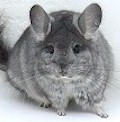Chinchillas are of small sized crepuscular rodents belonging to the Chinchillidae family, almost the size of rabbit. They are found in the Andes Mountains of South America. There are two different species of chinchilla, Chinchilla Lanigera and Chinchilla Brevicaudata. Although they look almost similar, the tail and ears of Chinchilla Brevicaudata is shorter, its shoulder and neck are broader and is found in the wild. The Chinchilla Lanigera species can be kept as pets. Their standard color is grey and they can also be found in ebony, beige and other colors.
Chinchillas are endangered species. They can be kept as domestic pets, but are very shy animals and are not good with small kids. Because of their fragile bone structure, they should be handled with care and that might be the reason why chinchillas don't like it when people hold them in their hands. Find more proper care products by following the FindSearchInfo.com/chinchilla.html link at the bottom of the article.
The life period of chinchillas is about fifteen years, when kept in captivity; some even survive till twenty or more years. They are noisy animals and make noises like squeaks, barks and chirps. They make noise to express their moods. They use a sweet chirping sound to attract another chinchilla for mating. They bark loudly when they get aggressive or scared. Chinchillas are social animals and can be kept together. When keeping the chinchillas of opposite sex, they should be neutered. A group of same sex chinchillas also does well, except that there is a chance of them fighting when a younger or older member is introduced in the group.
Chinchillas are very playful animals. Arranged shelves can be kept in their cage, which they can jump on. Toys like large wheel measuring more than eight inches in radius, hanging wooden toys, and paper towel cylinder can also be placed in the cage. In the link at the end of the article I list a site where you can find quality yet very cheap Chinchilla toys, and cages. However care should be taken that none of the objects should have a mesh structure as there is a possibility of chinchillas getting their legs stuck in it. Adding to this, when they are given wooden toys or wooden chew stick, the material shouldn't be conifer wood, because it contains resins which are poisonous to them. Even plastics should be avoided for the same reason as they will block their intestines I swallowed. The cage should be very airy and the bedding again shouldn't be of cedar wood. Birch, apple tree, willow, and Manzanita are good options for wood.
Temperatures should be maintained below seventy-seven degree Fahrenheit, because chinchilla don't have sweat glands and do not sweat. When the temperatures get really high, they get overheated and get a heat stroke. Since the animals are hyper active they should be made to spend at least half an hour outside their cage to exercise, in supervision. They clean their fur many times a week by taking dust baths. A container filled with special chinchilla sand dust and fine pumice should be kept in their cage for bathing purpose. Find all these products at the site listed on the bottom of the article The chinchillas shouldn't be given wet baths because their fur has the property to retain moisture and this could aid fungus growth. Even if they are given wet bath, they should be dried very fast with the help of blow dryer on a low setting.
Chinchillas shouldn't be given a sweet and fatty diet, like nuts and fruits, as their digestive system is very delicate. Their main diet can comprise of hay based pellet and loose hay. They can also be given small pieces of papaya and raisins sometimes. If they are fed with sugar products, they have a tendency to develop diabetes or diarrhea. Even fresh vegetables block their digestive system which can be very dangerous.
The cause of extinction of chinchillas is that they are killed on a large scale for its superb soft feeling fur. Also, they have a very evenly colored fur which makes it most apt for small apparels and as lining for bigger apparels. Although, now the wild species aren't hunted for fur, but domestic species are especially bred for this purpose. There are fur farms where chinchillas are bred in larger numbers. They are kept in really bad conditions. Still interested in Chinchillas? Make sure to go to my FindSearchInfo.com/chinchilla.html resource link below!
